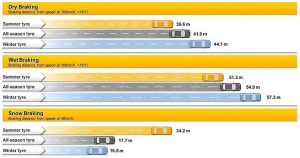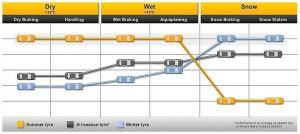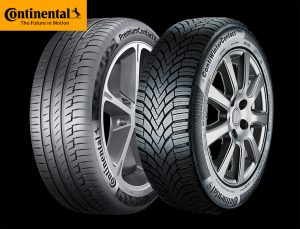Winter tyres? Really? It’s not as if we live in northern Europe, say Germany or Holland, where it snows a lot, right? Why bother?!
Unsurprisingly, it’s a not un-typical British response to winter tyres, after all, it hardly ever snows in the UK, right? It’s this very assumption – that winter tyres are for driving in snowy conditions – that is not only at the heart of our nation’s attitude to winter tyres but completely and utterly wrong. 100%.
In our latest tyre and driver safety article, we begin by busting this myth wide open. Once you understand the real truth behind winter tyres, it’ll change your perception forever. Read on…
Summer tyres, winter tyres – they’re all the same, right?
No.
While they may look the same at first glance, tyre professionals will initially point out that there are differences in the way the tyre treads are designed, with each tyre’s grooves designed to work optimally in the (summer or winter) conditions they’re designed for.
But this isn’t the really important difference. Funnily enough, it’s a difference you can’t see with your eyes, but which you would no doubt identify through feeling your vehicle’s handling and braking characteristics if only you tried winter tyres.
So what’s the crucial difference between winter and summer tyres? Simple. They’re made from completely different rubber compounds, with each designed to work at their best in very different driving conditions.
Seven – lucky for some, unlucky for others
Who would have thought that no matter what vehicle you drive and how many safety features come with it, your driver safety could come down to a simple, single digit number – seven.

Comparison braking distances using summer, winter and all-season tyres in dry, wet and snow conditions, from a speed of 62mph.
Your summer tyres offer better safety when it’s warm
Here’s the rub. Your summer tyres are made from compounds which are specifically designed for optimum use in temperatures above 7°C. The compound benefits from a warmer environment, and so as long as the temperature stays above seven degrees the tyre will work as intended.
But, use summer tyres below this temperature (which most of us do) and all of a sudden you’ll notice how they harden very quickly, and the driving properties you’re used to above 7°C go straight out the window.
Your winter tyres will offer you better safety when it’s cold
And the reverse is true of winter tyres when you use them in the summer, because they’re specifically designed for use in temperatures below 7°C. The simple misconception is that winter tyres aren’t just for driving in the snow, they for driving in the cold.
Why? Because the compounds for these tyres have been created to respond positively in cold weather conditions, retaining their suppleness to ensure their characteristics are their for you when you need them most. Think cold weather on an icy road and you realise just how precarious driving without winter tyres really can be.
And in case you’re suddenly thinking why not just use winter tyres all year round, remember that above 7°C they heat up too fast, and that impacts their rate of wear – think hot roads on blistering days. More importantly, they’re also not as effective at braking in summer conditions.
It’s these differences in weather conditions and the way compounds behave that has led premium tyre manufacturers like Continental to spend millions each year researching and developing tyre compounds for winter tyres, specifically designed to deliver the best performance in cold weather conditions, and compounds for summer tyres that perform optimally throughout the rest of the year.
Busting the myth once and for all
Let’s put this to bed once and for all. The fact is, snow is not the main reason why millions of drivers across northern Europe switch to winter tyres every year. Sure, they may well get a bit more snow than we do in the UK, but it doesn’t snow non-stop between October and March in Germany or Holland either, right?!
They change to winter tyres because the specially formulated rubber compounds employed in these tyres makes it much, much safer to drive when the temperature gets down to 7°C or lower.
When it does snow, winter tyres are also much better at coping with it than summer tyres, allowing drivers to continue driving safely, or at the very least to safety. Think about what happens in the UK when we do get a little snow – the country grinds to a halt. That’s no coincidence, is it?!
Alas, because we don’t get that much snow in the UK and because of the ‘snow tyres’ myth, we as a nation are simply not switched onto the idea of changing tyres in the winter. We should be, and now that you know the true reason for having winter tyres, you are too, right?
Hang on, what about “all-season tyres”?

A comparison performance of summer, winter and all-season tyres in a variety of weather and driving conditions.
Surely all-season tyres offer the best of both worlds, right?
Ah, if only it were that simple.
On the face of it, all-season tyres must seem like less hassle and less cost. But tyre experts still recommend switching. Why? It’s because all-season tyres aren’t nearly as good as summer tyres for braking when it’s warm – in both wet and dry conditions.
And they’re also not as good as winter tyres for braking when it’s cold, or in snow. And, like winter tyres, they adversely affect fuel economy. The difference is, they’re on all the time, not just for half the time, meaning you’re getting the worst of both worlds all of the time.
Still unsure about the benefits of winter tyres?
As the nights get darker and the temperature drops, recommend switching over to winter tyres. If you’re still unsure and want expert advice on the best tyres to buy for your car, speak to an Asda Tyres professional for impartial advice. Click here to live chat to one of our experts, or find your nearest fitting station.



